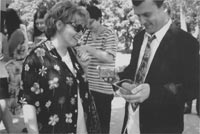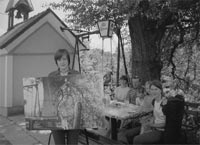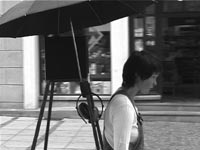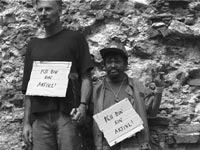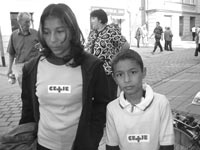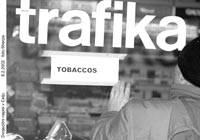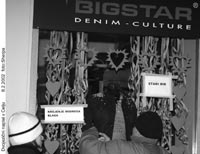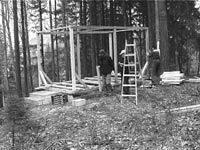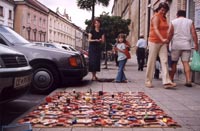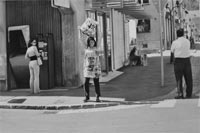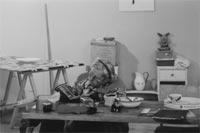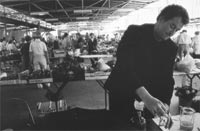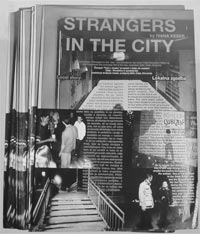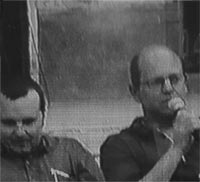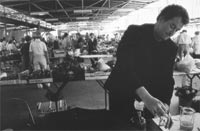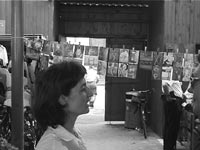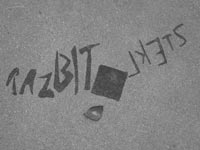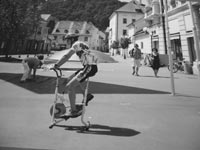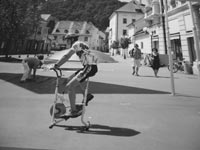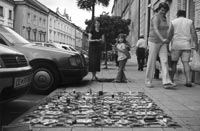Nevenka Šivavec
The Lure of the Local
In this text I will take the opportunity to try and show how the local cultural and artistic environment in which I work has changed during the last ten years. During my lecture in Kapelica I have limited myself to the presentation of the following projects: The Town of Celje, Alternatives of the seventies and The Town of Celje - Phantasms of the eighties. Since both exhibitions were accompanied by catalogues I will not deal with them at this time. I will try to describe (in short) the key moments that influenced the ever-increasing recognition of the art events in Celje. Of course I will describe them from my own perspective and experience. However, I would by no means like to expose myself and my curatorial position in the foreground, for my role in the projects that I am about to describe is merely that of a mediator. I see myself as a co-speaker and occasional co-ordinator of the complex local artistic network, which has played a part in the creation of almost everything that I am going to describe in this paper. Of course somebody could reproach me that as a representative of an institution, I operate from a position of power. In my defence I would like to state, that this was the main purpose for my attempts to create a network, which would at least partially diminish the position of power.
This year's project
entitled Vstop prost 5 (Free Entrance No. 5) encouraged me to describe
the projects, which include also some of the most current, still active
processes.
In the beginning of this summer the fifth annual Free Entrance project
took place in Celje. The carrier of this project is the Celje Association
of Artists. The project takes place every year in the form of an exhibition
in the Art Salon Gallery. On the opening day it also includes a series
of public interventions or performances at various locations in the town
centre. The most active artists in Celje co-operate at the project every
year. The participants do not have to necessarily be members of the association,
for sometimes also members of other associations are invited to co-operate.
This year's project was especially noticeable, for it had a certain consistency
as regards the contents, it emerged from the real town problems and the
public has, even though most of the projects were performed in the language
of contemporary art, the public approvingly participated or expressed
its disagreement. Three of the participating artists dealt with the issue
of the town park, which has been conquered during the past three years
by secondary school youth and has thus became unusable and even dangerous
for other age groups (children, cyclists, dogs, etc). The other projects
discussed the issues of homeless people, the lack of green areas within
the town and similar.
Free Entrance is a project in which I was not directly involved as a curator,
however the institution which I work for gives the organiser the space
and the basic infrastructure at their disposal. I consider Free Entrance
to be one of the most realistic indicators of the current state of the
local art community. I also think that the fact that this artistic community
produced a contemporary and vital product that can be read in multiple
layers is a positive symptom and a consequence of the past events.
Years ago the Celje association exhibitions were similar to any artistic
association exhibition - a few water colours, a few paintings, a graphic
print, a lonely statue - characterised by the stuffy air of provinciality,
of a closed milieu. Association exhibitions were (most probably they still
are in many places) a synonym for something that can be more or less predicted.
I am confident in stating that the fresh energy of the Celje local art
scene was greatly contributed by everything that we have done in the gallery
(as a town institution), for our work has generated intense communication
between artists and the institution, between artists and non-artists,
between formally educated artists, self-thought artists and outsiders.
Personally I was also deeply involved in this discourse. Throughout these
years I have been grateful to learn a lot from the artists and gradually
it became clear to me, which methods are appropriate for establishing
the local cultural discourse and identity and which ones are not. Exhibiting
famous, internationally acclaimed artists is of course necessary and desirable,
however, we should not on a regular basis and in a patronising manner
show 'real' artists from elsewhere to the local public. As was colourfully
and suggestively described by Lucy Lippard in The Lure of the Local it
is much more efficient to cultivate artists from the local source. I came
across this book in 1998 and as it will become clear I use it regularly
and I also try to make others realise the benefits of the good ideas described
within the book. Lucy Lippard discusses the great importance of preserving
the local specifics, i.e. events and spaces, for they can efficiently
support the events in the present. On the other hand they might have no
connection to the present as they might lean on overstated, idealised
events or even certain pseudo-utopia historic sources. The parallels with
the town in which I live have clearly shown themselves: immediately after
the declaration of independence the state as well as individual towns
tried to obtain a new cultural identity and Celje has impotently and humourlessly
attached itself to the counts of Celje. For this purpose even some historic
facts were discovered, which elevated them to princes. Thus Trg Svobode
(Freedom Square) was changed to Trg Celjskih knezov (Counts of Celje Square)
- does freedom have the wrong ideological connotation? We gained chivalry
games, a mediaeval day, Veronika's prize for poetry, etc. The cultural
identity of the town was thus firmly embedded in a sort of misty fairy-tale,
which can not have any connection to the present. It thus seemed necessary,
at least in the field of contemporary art, to find the true local roots.
Following the suggestive ideas of the artist Marijan Krošelj, Irena Čučnik
and myself came up with the exhibition The Town of Celje, Alternatives
of the seventies, which covered the extensive blank mark on the local
map. At the same time it has also proven to be a great surprise for entire
Slovenia. It shed some light on conceptual art, which was emerging locally,
independent from the centre, almost autonomously on the true margins.
It has also proven that the rehabilitation of this period with the historic
method was an extremely good move. The analysis of the 70's could easily
lean on the existing critical discourse of conceptual art, which made
it fairly compact and unproblematic. A much more open structure was present
at the exhibition The Town of Celje - Phantasms of the eighties. In this
exhibition I wanted to establish the example of local auto-poetics as
an initiative, a base for thinking about the simple and eternally unanswered
questions as regards the human primary desire for creativity. This research
was obviously unusual, unnecessary or strange for Slovene milieu, for
it did not receive any critical reflection whatsoever.
Over the years we have paid a great deal of attention to the local artists
in the Art Salon and the Contemporary Art Gallery. When there was a certain
lack of local artists we focused on artists that were connected to Celje
in any way. Thus we presented a whole array of local artists, students,
self-thought artists and the criteria for presenting them were pretty
slack. In fact, the only artists that we did not want to present were
the ones who have placed commercial success as their only criterion. I
will of course limit myself merely to a few projects in which I was directly
or indirectly involved, or projects that I have conceived by myself or
with others. One of them was a series of exhibitions entitled Neobičajne
dvojice (Unusual Pairs). I would find it hard to state that the project
was successful in its entirety, but in certain segments it encouraged
fruitful discussions and most probably influenced a lot of things that
can currently not yet be noticed. Unusual Pairs was conceived as an experiment,
with which we tried to encourage teamwork. The starting point was that
every exhibition would present at least two artists, who would otherwise
find it hard to be at the same exhibition due to their various conceptual,
aesthetic or even non-artistic reasons. The basic idea of Unusual Pairs
was thus to try and overcome the so-called artist's principle, which belongs
to the romantic aesthetic ideology. Within this project the artist was
invited to 'step outside of his ego', denounce his 'trademark' and thus
avoid non-solidarity individualism and self-promotion, which often accompany
an individual artist. The artists accepted these demanding starting points
in different ways. From the very beginning it was clear that Unusual Pairs
was conceived as a process that cannot be planned and foreseen in advance.
For some of the invited artists the challenge was too great, which resulted
merely in the exhibition of two artists in the same space, while others
used this starting point to develop projects that went into unexpected
directions. One of these pairs was represented by Jože Barši and Radio
Celje. The project took place in the media of the radio, while in the
gallery one could only see the internal daily radio programme. During
the time of the exhibition Radio Celje transmitted a 10-minute show every
evening at 10. In the show Jože Barši spoke to various people who explained
their everyday obsessions.
An unexpected turn was also made by the pair Andreja Džakušič and Radivoj
Mulić, who decided to sign up for the co-operation on their own initiative.
The main reason for the joint project was their common intimate history.
They decided not to produce new art objects for the Unusual Pairs project;
instead they opted to recycle. They changed the gallery space into a cosy
living area equipped with second-hand furniture and filled it with small
objects from their everyday life. The opening event was conceived as a
family and friends gathering at which the hosts prepared food for their
guests. Amongst other things Radivoj Mulić served a chocolate replica
of the Discus Thrower (which the guests were only too happy to attack).
With this action he meaningfully pointed towards their understanding of
the art object within a public space and the issue of the role of art
in everyday life. Their apartment, which was in public use within the
Art Salon Gallery, was not merely an approximate replica of an apartment,
but a truly useful space in which the guests and the gallery staff cooked,
ate and relaxed. Unusual Pairs have thus paid an important contribution
to the debate on the collective.
Important contents and debates were brought into the local events also
by the renewed issue of art activism and the social dialogue, which emerged
from the artistic operation. In relation to this I have to mention the
work of the so-called Skupina (The Group), the first public appearance
of which was within the frame of the Celje Povečava (Celje Blow Up) project
that was created and realised by Irena Čerčnik in the year 2000 and represents
one of the most important projects that have emerged from the local issues.
The project displayed various levels of thought and operation in town;
Skupina Miha 23, Brane 45, Franc 45, Tone 60 published its manifest in
the catalogue. In their manifest they emphasised (amongst other things)
that they are an informal group, which operates on a voluntary basis;
they endeavour to raise the urban culture, the quality and diversity of
life within the town. At the opening of the project they organised a round
table with a provocative title I Hate Celje.
The special feature of Skupina is that it is quite variable. Anybody can
leave the group, return for the next project, and anyone who is interested
can join it. In one of their projects I joined Skupina as an active participant.
At the moment they are involved in the project Borut's House. This is
a continuation of the project House from the Small Gallery Ljubljana by
Jože Barši, which will become the new home of the local artist Borut Hlupič.
Amongst the projects that successfully link the artistic practice and
the everyday life I would also like to mention the work by Boris Oblišar
in which he draws a parallel between his art and the educational system.
By constructing a visually attractive space installation from 'surplus,
refuse and attempts that have gone wrong' in the Celje Nulta Ura (Zero
Hour) he placed the 'surplus' into the field of the representational.
This gesture could be understood as a commentary or a pseudo-criticism
of the education system. His comments come from within the system, for
he is an active participant and actor within it. Oblišar does not use
the school material merely as the material for his own artistic operation,
for he also uses it to create an active intervention into the certain
circumstances of life into which all participants are involved. Zero Hour
became the trademark for an individual deconstruction of the system (Oblišar
also designed a logo for it), for the unconventional operation of the
users of this system, a sign for the space of freedom and a dialogue within
the more or less rigid institutionalised machinery. This is an artistic
operation, which without any provocation or spectacular, revolutionary
gestures efficiently changes its microenvironment through small steps.
Through the five-year continuous organisation of the already mentioned
project Free Entrance numerous Celje artists have managed to create names
for themselves. For many an artist his co-operation within this project
has radically changed the view of his artistic production in relation
to the environment within which it has emerged.
In this very brief overview I tried to show that the role of the gallery in a small town environment should not be merely of a representational nature, but could also function as an idea generator, catalyst and catcher of initiatives and signals that derive from its proximity.
